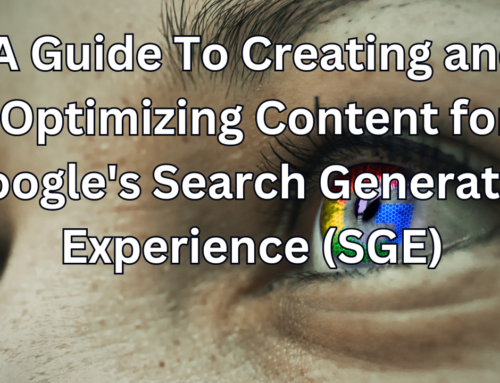The rapid evolution of the digital marketing landscape has made adaptability its only constant. Now, with Google’s Search Generative Expansion (SGE) joining the mix, traditional SEO content strategies to drive organic traffic are up for a major transformation. How, you ask? By shifting the focus toward search intent and building topical authority for businesses. So, buckle up and prepare to navigate this exciting change!
Before we dive into the several ways SGE will Impact SEO Content Creation Strategy, let’s review some of the background surrounding this significant change to Google search and SEO:
What is SGE?
Search Generative Experience (SGE) is Google’s latest AI-based search engine update, designed to deliver an improved search experience for users. It focuses on understanding user intent and delivering personalized results that match the searchers’ needs. This means the content you create must be tailored to meet the expectations of your target audience, making relevance and accuracy essential components of any SEO content strategy.
How will SGE Impact SEO Content Strategy?
1. Increased Focus on Search Intent and Topic Authority – With SGE, content must align with search intent and be comprehensive and authoritative on the topic, as opposed to a simple keyword match. This requires greater research and careful consideration of the questions people are asking about a certain topic at each stage in the buyer’s journey in order to deliver relevant responses.
2. Leveraging Semantic Search – Semantic search takes into account the meaning behind a search query, rather than individual keywords. This means that content should be written in natural language and focus on answering the questions people are actually asking.
3. Structured Data – Structured data helps search engines understand what your content is about, which can help improve its ranking in search results. Incorporating schema markup into SEO content will help ensure that your web pages are being indexed correctly and accurately.
4. Expanded Content Opportunities – With the introduction of SGE, new content opportunities arise for businesses. This includes creating content around long-tail keywords, voice search queries, video content, social media, YouTube, Podcasts, and more.
5. Fresh Content – Creating fresh content on a regular basis will be essential for staying competitive in the SERPs. Search engines favor up-to-date content, so be sure to constantly be refreshing and update existing content as well as create new pieces.
6. Optimized Landing Pages – Optimizing landing pages for SEO is important for improving visibility in search results, and this will become increasingly important with SGE. Ensure that your landing pages are optimized for both users and search engines by including relevant keywords, a clear CTA, and a well-structured page hierarchy.
7. Utilizing AI Tools – AI-driven tools can be used to optimize content, identify opportunities for improvement, and uncover insights about your target audience. They can also help you understand how people are searching and what types of content they’re looking for, which will become increasingly important with SGE.
Tailor Content to Both Users and Search Engines
SEO content should be tailored to meet the needs of both search engines and users. This includes creating educational content that provides value to readers, such as blog posts, how-to guides, infographics, videos, reviews, testimonials, and podcasts. Additionally, product or service pages should be optimized with relevant keywords and structured data.
Considerations for Generative AI-Powered Content
Generative AI-powered content can be a powerful tool for businesses looking to create SEO content that is both comprehensive and relevant. Generative AI-powered content uses natural language processing (NLP) to generate content based on user intent, allowing businesses to create content that is tailored specifically to their target audience. This type of content can also be used to quickly identify new topics and trends, as well as optimize existing content for better visibility.
SGE will have a major impact on how businesses create SEO content, with an emphasis on providing value to users and optimizing for relevance. By leveraging structured data, incorporating AI-driven tools, and creating comprehensive, authoritative content tailored to user intent, businesses can ensure their content is seen by the right people and rank higher in search results.
By utilizing the latest tools and techniques, businesses can ensure their content is optimized for SGE. This includes leveraging voice search and optimizing content for long-tail keywords, as well as creating video content and interactive content such as quizzes. Additionally, businesses should aim to create content that is engaging and provides value to readers. Utilizing user-generated content such as reviews or testimonials can also be a great way to boost visibility in search results.
Tactics To Consider When Creating SEO Content for SGE
1. The Importance of Search Intent and Personas
Understanding your audience’s search intent has never been more critical. With Google’s SGE, it’s not just about appearing in search results but aligning your content with what users are actively seeking. To delve deeper into why search intent and customer personas matter more than ever, please see the video above.
- Search Intent and Revenue
Ranking high on search engines is a complex interplay of several factors, and search intent is the driving force behind it all. By aligning your content with user intent, you increase your chances of attracting relevant traffic, leading to higher conversions and boosting your revenue. - Understanding the Customer Journey
The customer journey provides vital insights into creating marketing strategies that hit the mark. By understanding the different stages a customer goes through – from awareness and consideration to decision and retention – you can tailor your content to meet their specific needs at each point. - Four Types of Search Intent
Search intent typically falls into four categories: informational, commercial, transactional, and navigational. Informational intent covers general queries, while commercial intent indicates a user’s interest in a product or service. Transactional intent reflects a readiness to purchase, and navigational intent signifies a user’s desire to visit a specific website. - Keywords and the Customer Journey
Different stages of the customer journey correspond to different types of search intent, and consequently, different keywords. For example, ‘how-to’ keywords indicate informational intent (awareness stage), while ‘buy’ keywords suggest transactional intent (decision stage). A nuanced understanding of this alignment can significantly enhance your content strategy. - The Impact of Google SGE
Google’s SGE has ushered in a new era in search experience, offering direct answers and recommendations, and altering the research and buying process. This fundamental change makes understanding search intent and creating a tailored content imperative for businesses.
2. The Power of E-E-A-T (Experience, Expertise, Authority, Trustworthiness)
In the SGE era, Google E-E-A-T becomes the cornerstone of your SEO strategy. Showcasing your expertise, authority, and trustworthiness not only boosts your ranking on Google’s SERPs but also reinforces your credibility in your niche.
3. Elevating Topical Authority
Your content should be more than just relevant – it needs to cover related topics better than the competition and highlight your deep understanding of your industry. Building topical authority through comprehensive, high-quality content makes your website a go-to resource for your audience.
4. Strategizing Content Architecture
SGE underscores the importance of logically arranged, easy-to-navigate content. A sound content architecture not only enhances user experience but also signals the depth and breadth of your content to Google’s algorithm.
5. Harnessing Content Hubs
Content hubs – a central theme around which related content is organized – help establish your thought leadership, contributing to your topical authority. They serve as a rich resource for visitors and appease Google’s algorithm.
6. Creating Valuable Content
In the SGE context, content must be valuable and user-centric. Content that answers the audience’s questions, provides useful information and enriches the user experience rules the roost.
7. The Vital Role of Keyword Research
Despite the SGE update, keyword research remains crucial. Identifying and integrating keywords (especially search intent focused long tail keywords) that your audience uses in their search queries can increase your visibility
8. Prioritizing User Experience
User experience is at the heart of SEO, and the SGE update underlines this further. A site that is easy to navigate, with content that is easy to digest and provides the needed information, enhances user satisfaction and ultimately, your SEO standing.
Frequently Asked Questions
- What is Google’s Search Global Expansion (SGE)?
Google’s SGE is a new update that is poised to change SEO content strategies, emphasizing the importance of establishing topic authority for businesses. - Why is search intent critical in the SGE era?
Understanding search intent allows businesses to align their content with what users are actively seeking, increasing the chances of attracting relevant traffic, and leading to higher conversions and revenue. - What are the four types of search intent?
Search intent typically falls into four categories: informational (seeking information), commercial (researching products or services), transactional (ready to buy), and navigational (seeking a specific website). - How does the SGE update impact the customer journey?
Google’s SGE, with its direct answers and recommendations, has transformed the research and buying process. Understanding this change is essential for businesses to create tailored content that meets users at their stage in the customer journey. - Do I still need to try to get a featured Snippet?
Despite the need for content creators to focus on user experience, it is still important to strive for a featured snippet in organic search. Achieving this coveted spot can give your content more visibility, as Google will position it in the search engine results page (SERP). Conducting search engine optimization of your content with SEO best practices such as bullet points and numbered lists can help you get a featured snippet. Additionally, structuring the content around questions and answers, or including a table of contents can also help you stand out in the SERP.
Conclusion
The impending roll-out of Google’s Search Global Expansion (SGE) ushers in a new era of SEO content strategy. Emphasizing search intent, E-A-T, topical authority, sound content architecture, valuable content, effective keyword research, and user experience are the keys to surviving and thriving in this shift.
As with any significant change, this might seem overwhelming. However, it’s an opportunity to improve your SEO content strategy, making it more user-centric and ultimately, more effective. Start getting ready now to be at the forefront of this transformative period in digital marketing!




